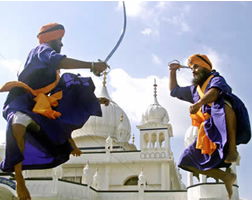 |
Nihangs
practising gatka © Pakistan Daily Times |
In the 17th century, the tenth Sikh guru, Guru Gobind Singh, was faced with the increasing tyranny of the Moghul rulers. As part of his attempts to get the local farmers to defend themselves, he designated the three days following the observance of Holi as Hola Mohalla, a time to be set aside for military exercises. The modern festival continues to be a showcase for Sikh martial arts, but it is also an occasion for competition of a more literary or musical nature.
The Sikh warriors of the time were known as Nihang, a reference to the alligator, another supreme fighter. Nowadays the name is applied to an order of Sikhs who continue to follow the lifestyle of Gobind Singh’s soldiers. Once known as the Guru di ladli fauj, the ‘Guru’s beloved army,’ the Nihangs are the main attraction of the present-day Hola Mohalla celebration. Wearing new blue robes and special turbans decorated with steel rings and circular symbols, they perform martial arts and mock battles known as gatka.
The Nihangs attempt to preserve their heritage by strict observance of rehat maryada, the Sikh code of social conduct. During the festival they observe a very spartan lifestyle, living in camps called chhaawni and eating with iron utensils.
Scholars have related the word mohalla to the Arabic mahalha, which means “a place for celebrating victory.” Observance of the festival today reminds Sikhs of the qualities that were crucial to their survival in the face of Moghul oppression: courage and the ability to stand up for oneself—whether on the battlefield or some other competitive arena.